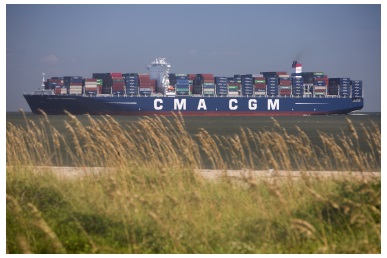Liner Shipping: Georgia
Savannah Serves Largest Container Vessel Ever to Call on North America East Coast
The 14,414-TEU CMA CGM Theodore Roosevelt, the largest container ship ever to serve the North America East Coast, called the Port of Savannah on September 1.
Working with seven cranes at the 1,200-acre/486 hectare-Garden City Terminal, longshore crews moved 4,500 containers (approximately 8,000 TEUs) on and off the ship. The GPA worked six other vessels simultaneous to the Roosevelt.
"Not only do these massive ships play to Savannah's strengths, they make us more efficient," said Georgia Ports Authority Executive Director Griff Lynch. "When Neo-Panamax vessels call on the largest single container terminal in North America, it maximizes the attributes that set Savannah apart: more space, more cranes and better landside connections."
Garden City Terminal features 26 ship-to-shore cranes and 146 rubber-tired gantry cranes. The GPA will add four ship-to-shore cranes in 2018 and another six in 2020, to bring the total to 36 cranes operating over nearly 10,000 feet/3,048 meters of contiguous berth space. Garden City Terminal is five miles from Interstate 16 and six miles from Interstate 95.
In just three months, the Port of Savannah has hosted 13 vessels with a capacity of 13,000 TEUs or greater. The average number of containers moving on and off these big ships is 8,000 TEUs per vessel. The 14,000-TEU CMA CGM John Adams is due in Savannah on September 7.
During the fiscal year that ended June 30, the Port of Savannah served 69 vessels with a capacity of 10,000 TEUs or more.
The Roosevelt is deployed on the new OCEAN Alliance's weekly South Atlantic Express (SAX) service, which connects Asia and U.S. East Coast ports via the Panama Canal. The SAX service includes 11 vessels ranging in capacity from 11,000 to 14,000 TEUs.
 CMA CGM Theodore Roosevelt enters the mouth of the Savannah River Friday, Sept. 1, 2017. The 14,414-TEU vessel is the largest to ever call on the Port of Savannah.
CMA CGM Theodore Roosevelt enters the mouth of the Savannah River Friday, Sept. 1, 2017. The 14,414-TEU vessel is the largest to ever call on the Port of Savannah.
Photo: Georgia Ports Authority/Stephen B. Morton

